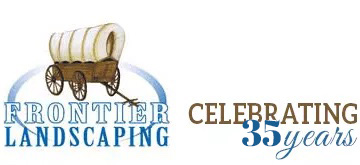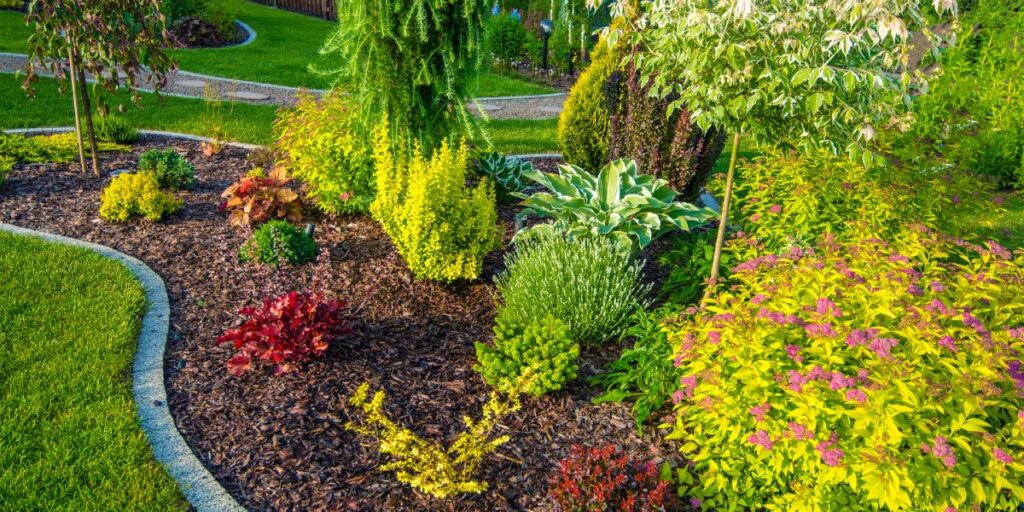
Incorporating drainage solutions doesn’t mean sacrificing the beauty of your landscape. Due to our rainfall, incorporating drainage is necessary to preserve the health of your plants, protect your home, and prevent erosion. Well-designed drainage solutions should become an integral part of your landscape.
Preserving Plant Health
Proper drainage is paramount to the health of your plants. Stagnant water around the roots can lead to root rot and other water-related diseases, compromising the vitality of your greenery. By incorporating drainage solutions such as French drains or gravel-filled trenches, you allow excess water to escape, preventing waterlogged soil and safeguarding the well-being of your plants.
Erosion Prevention
One of the most significant threats to a well-manicured landscape is erosion. Sloping terrain and heavy rainfall can lead to soil erosion, washing away valuable topsoil and leaving behind barren patches. Integrating solutions like retaining walls and strategically placed rocks helps control water runoff, prevent erosion, and maintain the structural integrity of your landscape.
Hardscape Protection
Proper drainage isn’t only about safeguarding your plants; it’s also about protecting your hardscape elements. Paved surfaces, such as driveways and patios, can suffer damage from standing water or excessive runoff. Installing permeable pavers or creating designated drainage channels ensures that water is directed away from these surfaces, preventing cracks, uneven settling, and other forms of deterioration.
Basement and Foundation Preservation
Improper drainage can have severe consequences for the foundation of your home. Excess water pooling around the foundation can lead to cracks, leaks, and structural damage. Implementing solutions like downspout extensions and grading adjustments directs water away from the foundation, preserving the integrity of your home and preventing costly repairs.
Options for Landscape Drainage
French Drain
A French drain is a perforated pipe enveloped in gravel. It quietly redirects excess water, protecting your landscape without compromising its visual appeal. From preventing waterlogged soil around plants to mitigating flooding, the French drain is often used in Pacific Northwest landscapes.
Channel Drain
These sleek linear drains, typically positioned in paved areas, efficiently collect and redirect surface water, preventing puddling and potential damage to hardscape elements. These are often used in driveways, patios, or walkways. Channel drains can be a good solution to surface water management in your

Incorporate Dry Creek Beds
A dry creek bed is an attractive bed of rocks that simulate a creek or river running through your yard. It can be used as a focal point and aids in landscape drainage.
Rain Gardens
Rain gardens offer several environmental and practical benefits, making them a valuable landscape drainage solution and staying sustainable. Rain gardens capture and absorb rainwater, reducing the amount of stormwater runoff that would otherwise flow into storm drains and potentially overwhelm local sewer systems. By slowing down and retaining rainwater, rain gardens help prevent flooding in low-lying areas during heavy rainfall events.
Add Gravel and Mulch
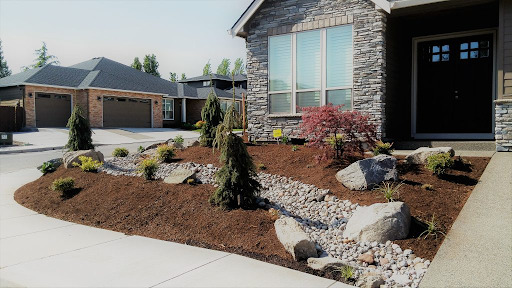
Mulch and gravel can both play important roles in improving drainage in your yard, but they serve slightly different purposes. Here’s how each can contribute to better drainage.
Mulch:
Water Retention:
Mulch, especially organic mulches like wood chips or bark, helps retain moisture in the soil. While it retains water at the surface, it also allows water to percolate into the soil slowly.
Soil Structure Improvement:
As organic mulch breaks down over time, it contributes organic matter to the soil, enhancing its structure. Improved soil structure promotes better drainage by preventing compaction and allowing water to move more freely.
Erosion Control:
Mulch provides a protective layer that helps prevent soil erosion caused by heavy rain or water runoff. This protection is crucial for maintaining the integrity of the soil and preventing the loss of topsoil.
Temperature Regulation:
Mulch acts as an insulator, helping to regulate soil temperature. This can be beneficial for plant roots, and it also contributes to the overall health of the soil ecosystem.
Gravel:
Surface Drainage:
Gravel is often used as a surface material in areas where water runoff is a concern. It allows water to flow easily over its surface, reducing the risk of soil erosion and preventing puddles.
Permeability:
Gravel is highly permeable, allowing water to pass through it easily. This is useful for areas where you want to drain and prevent water from pooling.
Visual Appeal:
Gravel can be a visually appealing addition to landscaping. It’s available in various colors and sizes, allowing the creation of different pathways or decorative features while still helping the drainage in your yard.
Add Plants that Tolerate Wet Soil

Plants can absorb excess water and improve soil and drainage in your yard. You may want to consider plants that can tolerate wet soils.
Plants for Soggy Sites:
Trees:
- Bald cypress
- Tupelo
- Water birch
- Cascara
- Red osier dogwood
- Willows
Shrubs:
- Buttonbush
- Purple osier willow
- Winterberry
Perennials:
- Blue flag
- Cardinal flower
- Japanese iris
- Japanese primrose
- Umbrella plant
- Water iris
- Maidenhair Fern
Grass and rush-like plants:
- Japanese sweet flag
- Rush
- Sedge (Carex elata ‘Aurea’)
- Sweet flag (Acorus calamus)
Integrating drainage solutions into your landscape is a proactive and essential step toward maintaining a healthy, vibrant outdoor space. Our team can design and install landscape drainage solutions that are functional and attractive. Give us a call today!
Landscape Drainage Solutions to Help Problem Areas
We get our fair share of rain in the Pacific Northwest, so it’s not uncommon to have some landscape drainage issues. Adding a rain garden or a dry creek bed are great drainage solutions that can even enhance the look of your landscape.
Water drainage problems in your yard decrease property value and can lead to costly water damage to your house and other structures, as well as plant and turf damage. With a little planning, you can alleviate your drainage issues to protect not only your yard but also your home.
How to Check Your Yard for Drainage Issues
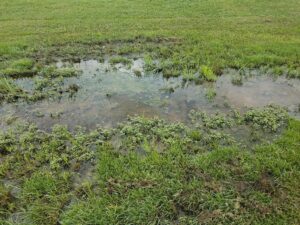 Pay attention to where the trouble spots are in your yard. Are there slopes that could be leveled out, mulched, or other materials added for draining? Is there an area with runoff from the driveway or gutters?
Pay attention to where the trouble spots are in your yard. Are there slopes that could be leveled out, mulched, or other materials added for draining? Is there an area with runoff from the driveway or gutters?
To get a rough idea of where the problems lie, take advantage of heavy rains to watch what happens to the water. Does it gush from the gutter and flood your flower bed or pool below your deck? Is there an area in your yard that becomes a swamp – or that remains swampy all year? Lawns and plants will die and/or become susceptible to disease and pest problems if they’re not able to dry out.
Does water run across the driveway or into the street during a hard rain or, worse yet, soak areas around your home’s foundation? In some cases, the grade was not established correctly and did not take into account that the ground should slope down and away from the house.
Level a sloping yard. To avoid incoming water, the ground should always slope away from your home in all directions. Locate the high and low points of your home and use extra soil to slope the yard away from your house. Melting snow and rain will flow away from your home.
Landscape Drainage Solutions
Native Plants
Choose native plants that prevent flooding in your yard. Native plants can help to prevent soil erosion while also allowing rainwater to drain more efficiently. Some selections for our area are Slough Sedge, Western Columbine, and Pacific Ninebark.
Mulch
Using mulch in your garden can prevent water from flowing toward your home. In garden areas, grade away from your home and fill with a few inches of mulch. This will help keep soil in place and hold in rainwater. If mulching near your home, make sure the mulch is at least six inches from your siding to avoid moisture wicking and rotting of your home’s exterior.
Rain Garden
Consider planting a rain garden. Rain gardens are the perfect solution for curbing erosion and improving water quality. They collect rainwater and water that runs from your gutters and downspouts, creating runoff and filtering it away from your house. They are often created in shallow, landscaped depressions, which helps to naturally absorb rainwater in the ground.
Dry Creek Bed
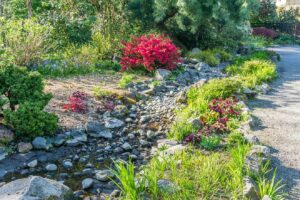 Install a dry creek bed to provide attractive and functional relief, especially if your landscape has standing water.
Install a dry creek bed to provide attractive and functional relief, especially if your landscape has standing water.
Dry creek beds are an excellent choice for addressing places in the landscape that are hard-hit by heavy rains. While a flat place in the yard may benefit more from a simple lawn drain, gradients and hillsides need the water capacity and speed that a dry creek bed can provide during extreme conditions. This drainage solution can be a nice addition to the look of your landscape by using different-sized rocks, boulders, and plantings.
French Drains
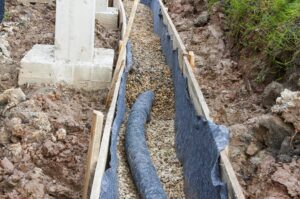 French drains are the most commonly used means of collecting, conducting, and discharging water. This is a trench filled with gravel, sand, or rock (depending on application) and containing a perforated pipe that redirects surface water and groundwater away from an area. The perforated (“weeping”) pipe also allows small amounts to seep into the ground along the way.
French drains are the most commonly used means of collecting, conducting, and discharging water. This is a trench filled with gravel, sand, or rock (depending on application) and containing a perforated pipe that redirects surface water and groundwater away from an area. The perforated (“weeping”) pipe also allows small amounts to seep into the ground along the way.
Frontier Landscaping offers landscape drainage services. We have years of experience with designing and implementing features that effectively carry water away from problem areas. Our expert installation team will determine the best place to collect excess water, the best method and route to conduct it, and an appropriate discharge point. We do the clean-up, too! Give us a call today!

Rain gardens are growing in popularity as drainage solutions for environmentally-conscious property owners. These carefully-designed landscapes add more than beauty to their surroundings. They are proven to have a significant impact in reducing the flow of contaminated water from urban areas to wetlands, streams, lakes, and other natural waterways.
Installing a rain garden is a powerful way to directly contribute a positive impact on the environment surrounding your home or business.
Why Do Rain Gardens Matter?
As communities grow and develop, buildings, roads, and rooftops replace native habitats. During times of precipitation, the original flow of water through the enviroscape is disturbed. Instead of being naturally filtered through pre-existing forests and soil, stormwater now flows at a high rate over hard surfaces and carries man-made pollutants with it. Erosion and increased flooding become problematic.
Additionally, the higher flow rate of water and contaminants that result from development cause real problems for regional aquatic life and water resources. However, rain gardens offer an exciting array of solutions.
- Slow erosion and alleviate flooding
- Decrease pollution and waste
- Clean runoff naturally
- Reduce the workload for wastewater facilities
- Can be created in public and private spaces of any shape and size, including businesses, residences, or public spaces
What Is A Rain Garden?
Rain gardens are bowl-shaped depressions in a landscape that collect and clean rainwater runoff from hard surfaces nearby, like driveways, roofs, parking areas, and patios.
They are designed with special soil mixes that allow speedy absorption of water — usually a combination of sand, topsoil, and compost. This amended soil filters runoff and also supports a variety of plant growth.
Note: Rain gardens are not permanent ponds. They are sized to allow temporary pooling after rain. In a well-designed garden, all water passes through very quickly, typically from one to two hours (maximum of one to two days) after a storm. This prevents stagnation and mosquitoes.
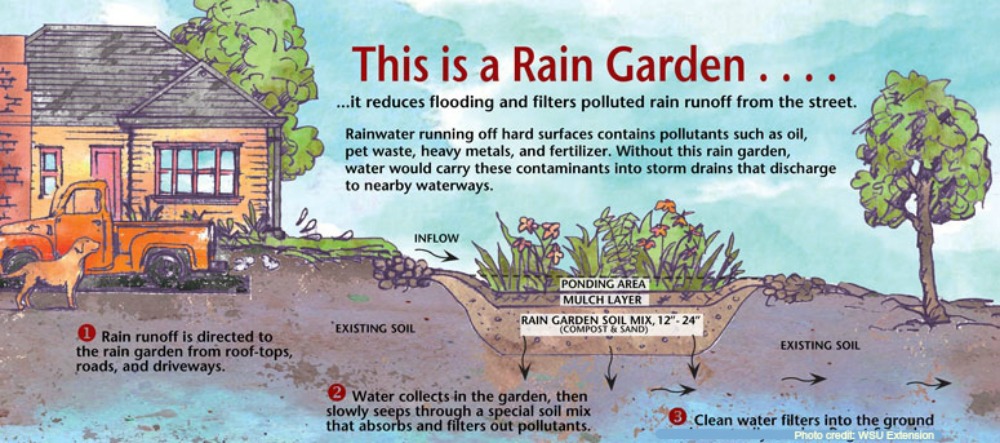
Photo: WSU Extension
There are a number of ways water can be diverted to a rain garden through a landscape. It may be that one approach works well for a back yard/patio area, but a different one is more effective for dealing with runoff issues in the front.
Design Features of a Rain Garden
Soil
Soil is where it all begins. Reworking the ground to provide the right blend of soil, sand, and compost is critical to having a healthy rain garden. Absorption, drainage, and filtration all rests on getting this foundation prepared correctly.
Plantings
There are three planting zones in a rain garden:
Zone 1 The wettest area, at the bottom of the rain garden. Important to install plants in this zone that can handle “wet feet” for several hours at a time.
Zone 2 The sloped sides of the garden, which may become wet from time to time. These plants provide stability and prevent erosion.
Zone 3 The perimeter of the rain garden, with the driest soil.
Since rain garden design is based on earth-friendly practice, using native plantings to fill out the three zones makes a lot of sense. Native plants create a nourishing habitat for local wildlife, birds, butterflies, and other important pollinators.
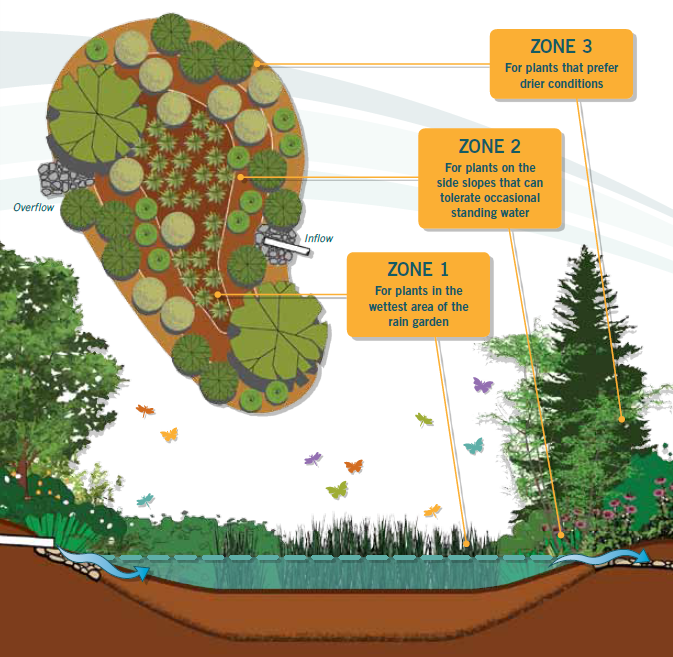
Photo: Washington State Department of Ecology
“Plants and soil work together in the rain garden. The plant roots and soil organisms build soil structure, create channels and pores to soak up and filter water, and improve nutrient and oxygen availability necessary to support an abundance of life. While plants help the rain garden absorb stormwater, they also create an attractive landscape for your yard and neighborhood.” — WSU Extension, Rain Garden Handbook for Western WA
How to Know If A Rain Garden Is Right For You
A rain garden may be a good fit for you if you answer “yes” to the following questions:
- Do you want to improve the landscaping and appearance of your property?
- Would you like to directly reduce the amount of pollutants reaching groundwater and storm drains in your community (as well as wetlands, streams, and other natural waters)?
- Would you like to reduce flooding, prevent sewer overflows, and erosion in streams by absorbing runoff from hard surfaces?
- Is providing habitat for beneficial insects and birds important to you?
- Would you like to be responsible for recharging local groundwater by increasing the amount of water that soaks into the ground on your property?
Let’s Get To Work
Frontier Landscaping offers professional expertise and support for residential and commercial clients committed to environmentally-conscious landscaping. While the best time for testing soil drainage and groundwater levels is in late winter months, we are available to walk you through the planning process for a rain garden at any time of year:
- Site assessment & testing
- Garden location
- Soil amendment & excavation
- Planting requirements
|
- Design aesthetic
- Maintenance goals
- Compliance with city/county regulations
- Long-term success
|
Call (360) 574-8979 or contact us to get started on your path to a cleaner, greener future.
Additional Reading: Washington State Extension Rain Garden Guide
We enjoy working with homeowners who want to use ‘green’, earth-friendly practices in their landscaping. After all, making decisions about land and water use in environmentally responsible ways feels great.
However, we’ve realized that there are some common assumptions about “going green” that are not always on target, particularly with regards to hardscaping. With that in mind, we’re glad to share what we know to help you avoid missteps.
With a little understanding, you can be confident that your results will be in line with your goals for a beautiful, sustainable landscape.
Going Green with Pavers
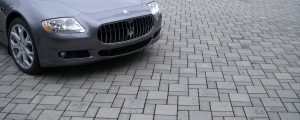 Without question, pavers are hugely popular for creating patios, pathways, and even driveways.
Without question, pavers are hugely popular for creating patios, pathways, and even driveways.
Hailed as earth-friendly heroes, they’ve moved into the top spot over concrete for two reasons: they’re available in a wide range of beautiful materials, shapes, colors and sizes, and they are marketed as a solution to handle runoff faster and more responsibly than concrete.
This is true if you use the right paver, but often some drainage is still needed.
While they do allow some water through easily, if you really want to guarantee these benefits in your landscape, you must choose a truly permeable paver for the job. Standard pavers are hard packed with sand and compacted gravel beneath them and product inbetween.
Permeable Pavers Pro Tip
To be sure your patio, pathway, or driveway gets the full advantages pavers can offer, choose a product specifically designed to allow gaps and drainage. While pretty versions of these materials used to be few and far between, innovators in the industry are now offering solutions that are beautiful to look at and effective. Locally, we partner with Mutual Materials to offer a variety of Eco-Priora® and Eco-Stone® options that can be laid in attractive patterns for patios, driveways, and pathways.
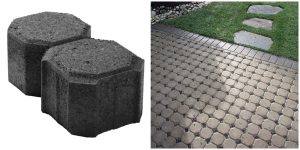
Hardscaping and Lawn Loss
Replacing turf lawn with hardscaping is another trend where it’s easy to get tripped up. Hardscaping is dramatic, beautiful, visually interesting, and requires less water use and less maintenance that keeping a lawn. It’s easy to assume that getting rid of the lawn is the right answer.
On the other hand, as more and more property owners are replacing trees and grass with hardscaping on the West Coast, it’s becoming clear that lawns have significant earth-friendly advantages of their own.
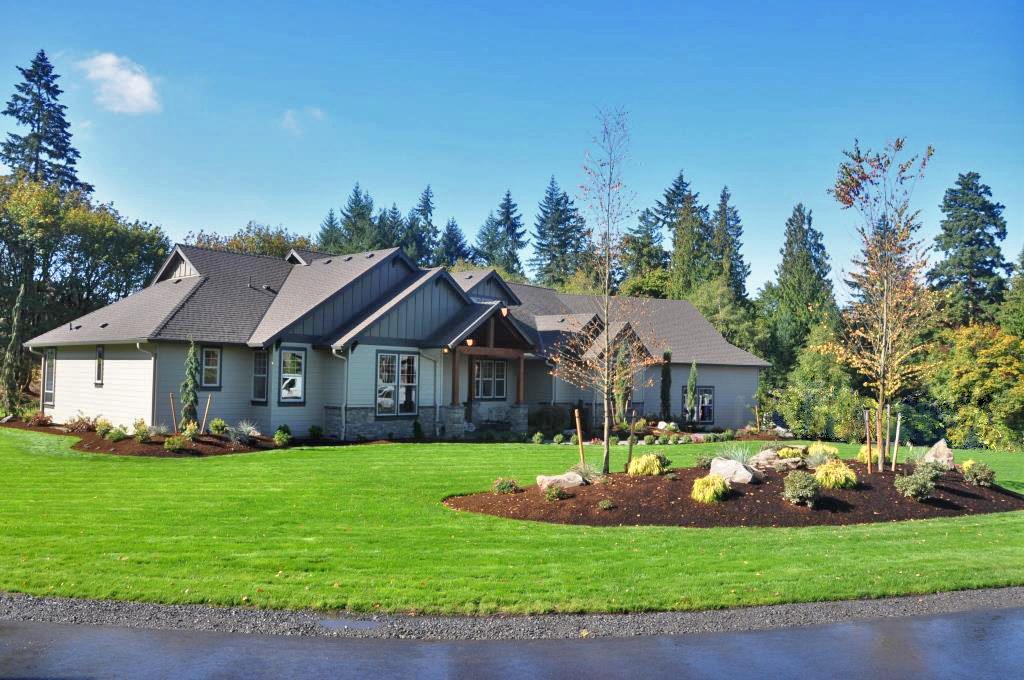
Green spaces and trees absorb heat and clean the air with their intake of carbon monoxide, two of the primary reasons the Pacific Northwest enjoys such high air quality and a temperate climate. Foot for foot, a healthy lawn will outperform even an eco-friendly paver patio with superior drainage and its clean water benefits.
Lawn Loss Pro Tip
Plan for balance, not elimination. Even a small yard can be designed to keep a percentage of everything: lawn, beds, plantings, and hardscaping.
Remember that nearly every element of your residential or commercial landscape can be designed with environmental responsibility in mind. Our expert team loves working with home and business owners to use the best practices available.
Learn More About Going Green In Your Landscape:
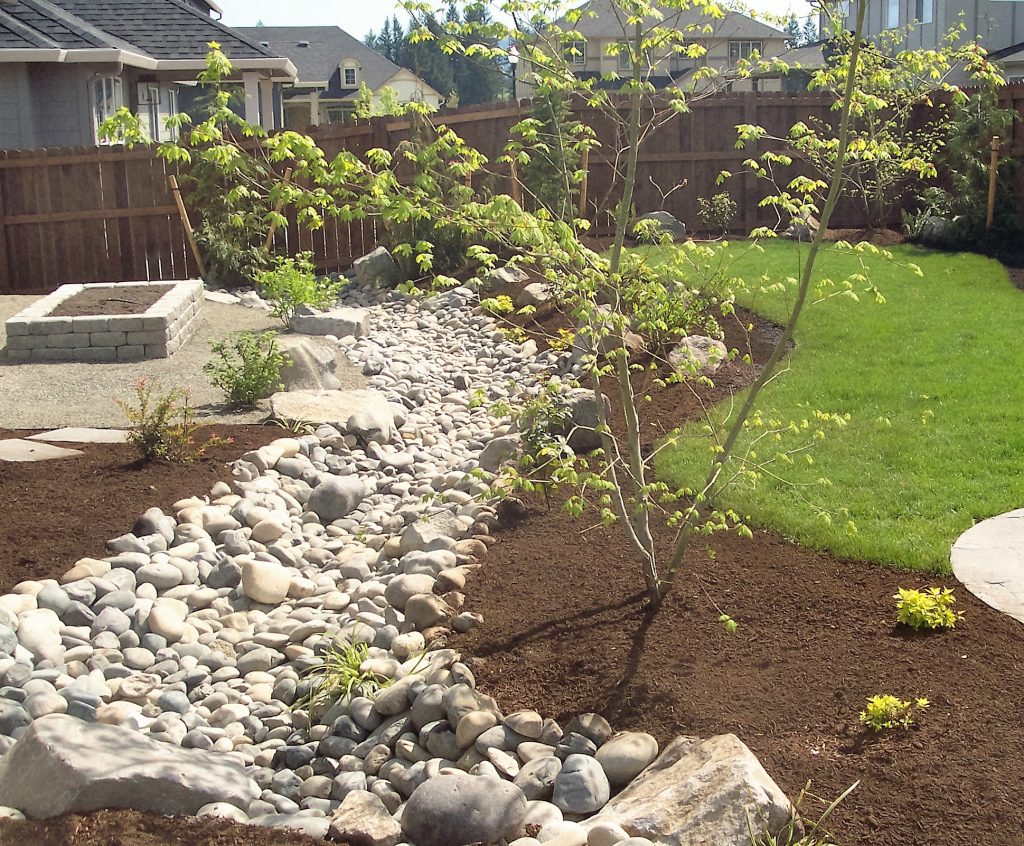
Dry creek beds provide attractive, functional relief, especially if your landscape is plagued by standing water. In the wet PNW, drainage problems are a common headache. Do any of these sound familiar?
- Floo
 ded flower beds
ded flower beds
- Pooling water below a deck
- Swampy places in the lawn
- Puddles around a foundation
Leaving drainage issues unaddressed has serious consequences, from dead lawn and plants to costly repairs and decreased property value.
The Good News
Frontier Landscaping has years of experience designing and implementing features that effectively carry water away from problem areas. Dry creek beds are star performers, particularly in sloped terrain. They work twice as hard for a landscape by running water from Point A to B, and standing alone as an attractive feature in drier months of the year.
“Even property owners with no landscape drainage issues may choose to install a dry creek bed due to the elements of natural beauty in the way they look.”
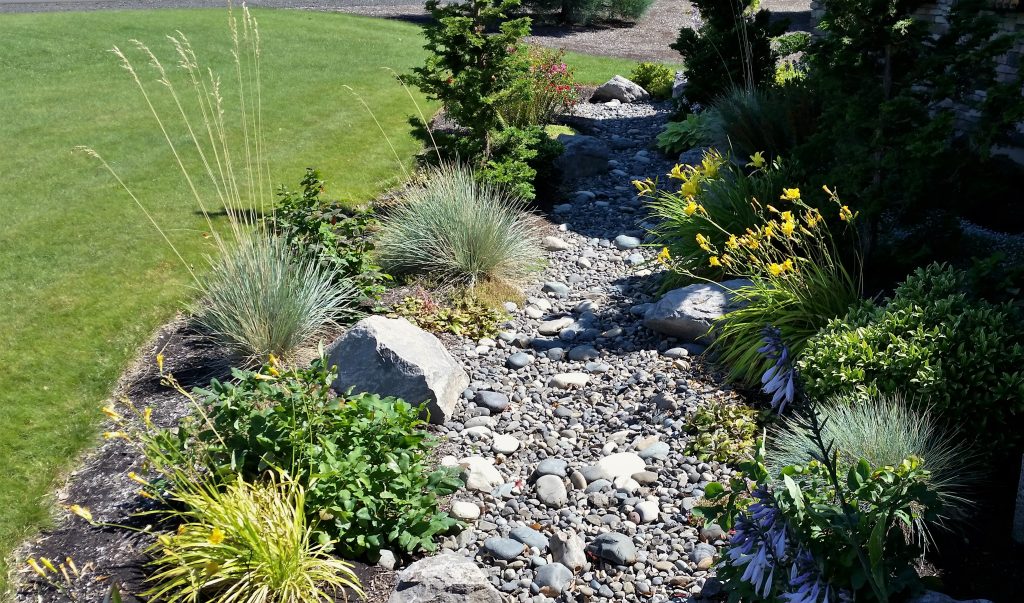
Controlling Water Flow
Dry creek beds are an excellent choice for addressing places in the landscape that are hard-hit by heavy rains. While a flat place in the yard may benefit more from a simple lawn drain, gradients and hillsides need the water capacity and speed that a dry creek bed can provide during extreme conditions. Effectively redirecting the flow of water saves you from ongoing erosion and long-term damage.
Water-Wise Gardening
When property owners are looking for a greener way to landscape, dry creek beds play an exciting role. Different-sized rocks, boulders, and choice plantings give eye-pleasing texture to outdoor spaces, but require much less water than an expanse of lawn. While bark dust alone can look flat, a dry creek bed introduces definition and contrast. It’s aesthetically pleasing and earth-friendly — a winning combination.
Dry Creek Beds for Natural Beauty
We regularly install dry creek beds to add natural beauty to a landscape. Expertly balancing a few key ingredients (a natural shape, native plantings, multiple sizes of stone) brings a natural, organic flow to an area. The results are breathtaking in any season, wet or dry.
Additional Considerations
No two landscapes are exactly alike, and the solution that works for one may not work for another. While dry creek beds are particularly suited to slopes and hillsides, they aren’t usually the best choice for flat ground.
Other elements, like French drains, catch basins, and lawn drains also have a part to play — and that’s just the beginning. Frontier’s installation team has years of experience solving drainage problems for local property owners.
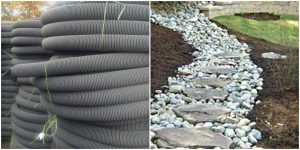
French drain pipe (L), installed as a garden path (R).
French drains are a functional solution for flat terrain and less water. They often have a part to play in designing an overall solution for moving water in a landscape. Read more about them here.
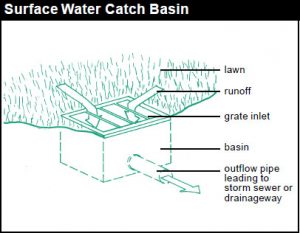
Ranging in size from 6 to 24 inches, catch basins can be square or circular. These grated drains are typically placed alongside a driveway or in a low or sloped spot in the yard or hardscaping, like a patio. This is a straightforward fix for diverting water away from wet spots. A blend of rocks around it allows the catch basin to blend in with the landscape.
From basic to beautiful, there are many combinations of elements we can put to work that provide an effective long-term solution for landscape drainage issues in your landscape.
Ready to learn how can we help you solve your standing water problems? Call (360) 574-8979 or email us for a consultation. We’ll work with you to protect your landscape with the right landscape drainage solutions to meet your needs.
Find more inspiration for dry creek beds and landscape design by visiting us on Houzz!




